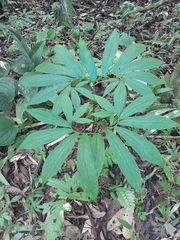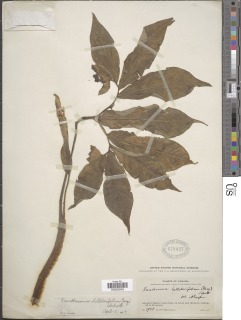

|
|
|
|
Family: Araceae
Belembe-Silvestre
|
Terrestrial, occasionally more than 1 m tall, glabrous; caudex tuberous, the leaves and peduncles arising from the ground. Petioles thick and succulent, the lower part broadly vaginate-winged; petioles and parts of leaf rachis with characteristic textured pattern of maroon and white but predominantly maroon; blades reniform in outline, deeply dissected, the central lobe to 30 cm long and 7 cm wide; rachis branching, curving to both sides; leaflets 5-18, thin, sessile and diminishing markedly in size toward either end, oblong or lanceolate, acuminate, cuneate at base; veins prominent, the collecting vein within 5 mm of margin. Peduncles 40 cm long or more, textured like petiole and rachis; spathe to 19 cm long, enveloping spadix, the blade white or greenish at anthesis, soon withering, the tube green, persisting, broad in fruit; spadix white, to 17 cm long, with a broad short stipe, the staminate part ca 10 cm long, the sterile staminate part constricted apically, much broadened basally, the pistillate part ca 2.5 cm long. Fruits not seen. Croat 10892, 11483. A common species of clearings and very open trails in the forest. The plant dies back after the beginning of the dry season and reappears shortly after the rains begin, flowering mostly from May to September, with inflorescences repeatedly produced. The fruits develop within about 1 month. El Salvador to the Guianas and Amazonian Peru; the Antilles. In Panama, known from tropical moist forest in the Canal Zone and in San Blas and Panama and from premontane wet forest in Coclé (El Valle). |









































